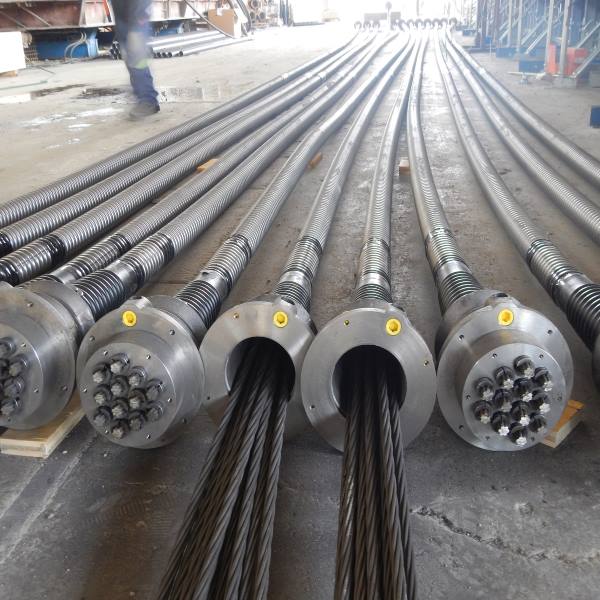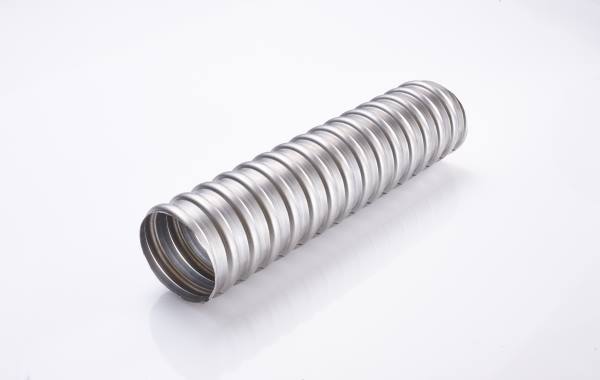
Sheaths for Prestressed Concrete DIN EN 523
The purpose of the cladding tubes in prestressed concrete with subsequent bonding is to create a tension channel in the structural concrete that allows the tension rods to slide with little friction.
Advantages:
- economical to manufacture
- available at short notice
- easy handling due to low weight
- high mechanical strength
- high shear bond due to profile geometry
Requirements

Leakage Resistance
Sheathing pipes must ensure that no cement slurry penetrates the prestressing channel from the outside during concreting. After loads from rough construction site operations, the weld or seam seam shows no damage and the pipe has no kinks or dents.

Bending Behaviour
Sheathing pipes must be stiff enough so that they do not sag between the support points, but also flexible enough to adapt to the course of the respective tendon. Longitudinal stiffness is a decisive criterion, particularly where the sheathing pipes are laid without internal bracing and the prestressing steels are only pulled in after the concrete has been poured and hardened. Flexibility, on the other hand, is required when tendons are manufactured in the factory and transported to the construction site as drums or rings.

Resistance to Transversal Stress, Tensile Strength
Sheathing pipes are exposed to a variety of mechanical stresses, e.g. when the prefabricated tendons are wound up and down, or when the prestressing strands are “shot in”. Wall thickness and profile shape, as well as the connection points, are crucial to avoid damage to the pipe/tendon.

Corrosion Protection and Bonding
The profile shape, pitch and tightness influence the flow process of the grout and enable the cavities between the prestressing steel and the duct to be pressed together without gaps. This ensures permanent corrosion protection for the prestressing steel and the necessary bond for the transmission of forces from the tendon to the duct and from the duct to the surrounding concrete structure.
Tube types – Category 1
Category 1 ducts can be manufactured with smaller wall thicknesses, since the ducts are laid with the
tensioning strands (as prefabricated tendons or during tendon production on site)
and only then is the concrete poured.
Typ 7111 – longitudinally welded
Diameter range DN 30 to 95 mm
The wide inner shaft increases the sliding surface of the cladding pipe. This ensures that the prestressing steels are evenly supported. This avoids increased frictional resistance when pulling in and tensioning the prestressing steels. The profile geometry also ensures the necessary bending ability despite the high bending and transverse load resistance.

Typ 7631.02 – strip wounded
Diameter range > DN 95 mm
Construction challenges make it necessary to use larger tendons for prestressing. With these large tendons, it is important to have a stable pipe that is able to withstand these loads due to the shape of the profile.

Typ 7421 – flat oval cross-section
Flat oval ducts are used to be able to use multi-strand tendons in prestressed concrete structures with small cross-sections (e.g. installation in ceilings). The shape of the radii is an important criterion for oval ducts. The “roundness” of these prevents the prestressing steels from snagging in this area. This shape also facilitates the seamless pressing of the tendons.
Tube types – Category 2
The so-called heavy version has proven to be particularly effective when the ducts are laid empty and cast in concrete, i.e. without prestressing strands. The main factors here are the shear load and peak compressive strength, which is achieved by a greater wall thickness. Otherwise, the same criteria and advantages apply as for category 1.

Typ 7211 – longitudinally welded
Diameter range DN 40 to DN 95

Typ 7631.02 – strip wounded
Diameter range > DN 100
Accesories

Screw connectors
The sheathing pipes are usually supplied in individual lengths of 5 – 6 m. The individual pipes are assembled to the respective tendon length using screwable connecting parts. The connection point must be tensile-resistant, which is why the threads must not have excessive tolerances. The connection points must be sealed with suitable adhesive sealing tape.

Prestressing accessories
When the tendons are grouted with the grout, the air inside the tendon must be able to escape. There are various accessories available for this purpose, which can be put together to suit your needs.

Transition pipes
For the transition from the tendon to the anchor or coupling point.
Individual custom-made products.
How can we help you?
wbr Rohr- und Bauelemente GmbH
Otto-Hahn-Straße 17
D 75248 Ölbronn-Dürrn



